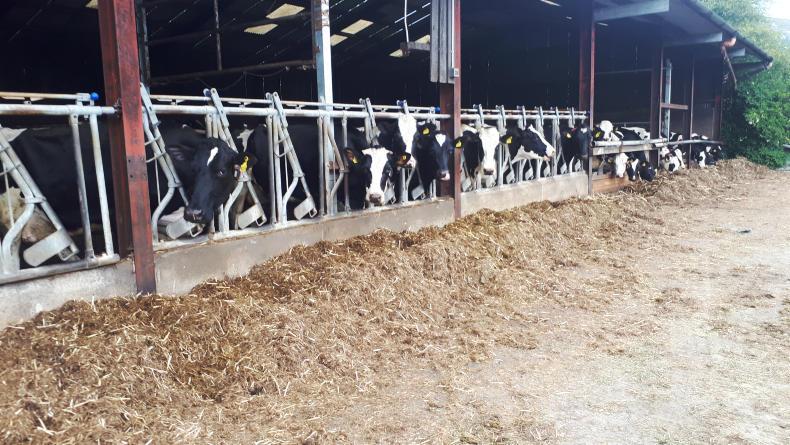Everything and everyone seemed very relaxed when I called into the Martin household in south Armagh last Friday.
Everything and everyone seemed very relaxed when I called into the Martin household in south Armagh last Friday.
The reality is that James, Owen and Rosie were in recovery mode after an exhausting few days at first-cut silage.
Over 220 acres of first-cut silage were harvested and ensiled. James was on the John Deere 7200 harvester, with Owen charged with building the pit.
Remember, the system on this farm is that milking cows stay inside all year. Milk is produced 365 days a year in a flat supply profile.

Young stock still inside on the Martin farm near Dromintee, south Armagh, in May 2019.
Grass silage forms the mainstay of the cows’ diet, with meal fed in the parlour and a blend in the diet feeder. The importance of quality silage isn’t lost on James.
“Silage quality is crucial to our system and this is where we need to focus. We need to put more focus on soil fertility to drive better-quality grass that will make more and better-quality silage so we can potentially feed less meal.”
What makes this Dromintee silage campaign different from most other farms is that James and Owen, with help from some locals, cut, rake and collect all the grass silage themselves.
They have a secondhand John Deere harvester and four silage trailers that hit the road when the campaign starts. None of the machinery is new, but all are fresh, functional and well cared for.
“We are very lucky to have some great local help, family and others, that we can call on for the few days it takes to bring the crop in,” said James.
“Without that, it would be hard to make it work.”
We did up some very quick back-of-the-envelope figures on the cost of making silage.
The big variable cost is the estimated 3,000 litres spent on diesel (buck rake, harvester and four tractors on a draw up to eight miles), with relief labour the other big cost.
There is of course a very big machinery cost that needs to be accounted for over a five- to 10-year period.

The new covered silos (100ft x 110ft) will be the main silos for 2019. Estimated net cost is £100,000.
The advantage of this family job is that they have more control over time of cutting, etc, and hence this should influence better quality.
The Martins also maintain it works out more cost-efficient compared with maybe paying £65 per acre (£14,300 for a 220ac first cut).
The other issue worth considering here is that this is the first of potentially four cuts this year and every year.
As cows and youngstock are inside the majority of the time, the forage demand is high. Remember, these are high-producing cows (10,000 litres delivered per cow), so intakes are high.
The plan for the next few weeks is to get slurry and nitrogen out on recently harvested fields, with a view to harvesting again in early July.
One of the issues we considered on Friday was the labour challenge with all this machinery work.
Cow numbers are slowly increasing as planned (currently 147 milking, heading for 160-ish), but, as Conail Keown said: “More cows will bring more work, such as more silage required, more youngstock, more management and handling, etc.”
James was hoping to get some local help for the summer months to help with the machinery work primarily.
Both James and Owen like working with the cows so milking is not a chore, and the 24-unit ATL plant makes milking busy, but a relatively short piece of work morning and evening.
James was considering ensiling some caustic-treated wheat this year, but both CAFRE Dairylink advisers Aidan Cushnahan and Conail Keown were not in favour. James had intentions of maybe undersowing grass seeds and wheat, but neither adviser saw a huge benefit and both preferred to purchase a crop of wheat if really necessary as a feed source rather than grow and harvest the crop. It remains under discussion.
Calves
Calves continue to appear every week. Once a calf appears, it is taken to an individual hutch. James proudly allowed an MVP-sired (Genus) heifer calf that was born last week to leave the small hutch and stretch out in front of the farm visitors.
James explained that his rationale for breeding decisions is better fat, protein, with improved fertility traits, and type. Most sires also bring 300kg to 400kg of milk. Sires such as Agronaut (£PLI 819) and MVP (£PLI 476) fit the bill for James and Owen. Suck calves get an IBR vaccine and cows get a Rotavirus vaccine, but little else.
Read more
Dairylink: fine-tuning grazing and soil fertility in Down
Watch: Dairylink Ireland farmers getting to grips with grass growth





SHARING OPTIONS: